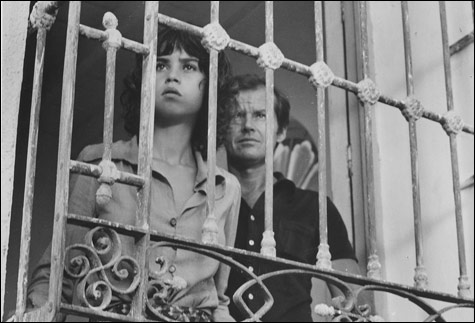 |
It seems inherently wrong to be writing an obituary for Michelangelo Antonioni, who died July 30 in Rome, just a day after we lost Ingmar Bergman. No director did more to combat the idea that a movie is an illustrated novel. His mature films, beginning with Il grido, pare the dialogue to an unsettling minimum; you could watch his most celebrated effort, L’avventura, without subtitles and follow almost everything. That was one of his two revolutions; he also created a post-Copernican cinema where human beings are not always the center of the cosmos. They’re not even always the center of his shots — his camera is apt to focus on some interesting landscape or building detail while people wander in and out of the frame. In L’avventura, what looks like the main character, Anna (Lea Massari), wanders out of the story and never wanders back in. “People disappear every day,” the Girl (Maria Schneider) tells David Locke (Jack Nicholson) in Antonioni’s last great film, The Passenger. “Every time they leave the room,” Locke replies.
Antonioni was also adept at making audiences disappear. L’avventura was hissed when it premiered at Cannes in 1960 and the audience realized that Anna wasn’t going to reappear and ask Claudia (Monica Vitti) and Sandro (Gabriele Ferzetti) why they were making out with each other instead of looking for her. At least Claudia and Sandro are still there at the end. Two years later, it was L’eclisse that got booed at Cannes. Its two lovers, Piero (Alain Delon) and Vittoria (Vitti), have promised to meet at the usual spot at 8, and Antonioni’s camera settles in for the anticipated conclusion, whiling away the time by checking out an automatic sprinkling system and a rain barrel and a building under construction and leaves rustling in the wind. Darkness falls, and after seven minutes of no Piero, no Vittoria, no dialogue, and only a few incidental passers-by, the film ends in a blinding close-up of a street lamp. Some suggested that the eclipse of the title was Antonioni’s own.

He came from Ferrara, in the misty Po Valley, the town of Renaissance artist Cosmè Tura and the novelist Giorgio Bassani (Il giardino dei Finzi-Contini). Born in 1912, he didn’t make his first feature, Cronaca di un amore, till 1950, and it wasn’t till 1957, four Neo-Realist films later, that his mature style began to crystallize, with Il grido, the story of an emotionally isolated Po Valley sugar-refinery worker. There followed the seven films for which he’s best known: L’avventura (1960), La notte (1961), L’eclisse (1962), Il deserto rosso (1964), Blow-Up (1966), Zabriskie Point (1970), and The Passenger (1974). Then, as with almost every other ’60s auteur, the fade-out: Identificazione di una donna in 1982, a stroke in 1985, Beyond the Clouds, with Wim Wenders, in 1995. It’s the small body of work you expect from an uncompromising filmmaker. Il grido took in a paltry 100 million lire at the box office; L’avventura just about broke even in Italy. The three-film deal with Carlo Ponti and MGM that produced Blow-Up, Zabriskie Point, and The Passenger brought financing but also the usual major-studio headaches, like the key scenes cut from the American version of The Passenger. Film-festival juries tended to like his films — La notte won the Golden Bear at Berlin in 1961, Il deserto rosso the Golden Lion at Venice in 1964, Blow-Up the Palme d’Or at Cannes in 1967 — and he’s been a critics’ darling. Yet, decades later, opinion is still at odds over — and mostly weighted against — his American counterculture film, Zabriskie Point, which he made with non-professional and seemingly untalented leads, Mark Frechette and Daria Halprin. (It cost $7 million and grossed less than $900,000.) And though everyone agrees that Blow-Up is a major 20th-century movie, no one seems to know what it’s about.
Good or bad, Antonioni’s films always start from cinema year zero. The narrative, when there is one, implodes: Sandro and Claudia don’t find — or even look very hard for — Anna; Thomas (David Hemmings) in Blow-Up doesn’t solve the murder he appears to have photographed. The characters are blank slates, usually with just first names, sometimes with none at all. (The characters played by Hemmings and Vanessa Redgrave in Blow-Up are called Thomas and Jane in the screenplay but not in the film.) The actors don’t act so much as react to the situations Antonioni places them in. The dialogue can be pointed: Vittoria telling Piero, “I wish I didn’t love you, or that I loved you much more”; Giuliana (Vitti) in Il deserto rosso telling Corrado (Richard Harris), “If Ugo [her husband] had looked at me the way you do, he’d have understood many things.” More often characters speak at cross-purposes — famously Thomas and Patricia (Sarah Miles) in Blow-Up — or offer suspect wisdom. The editing defies convention: “important” events are elided (how does the Girl get from the front seat of Locke’s car to the back?), “unimportant” ones go on and on (the interminable shot of Claudia running down the Taormina hotel hallway had the Cannes premiere audience yelling, “Cut!”). And sequences are mismatched, like the one in The Passenger where you’re led to believe you’re looking at the African desert from Locke’s point of view and then suddenly there he is driving his Land Rover into the shot.